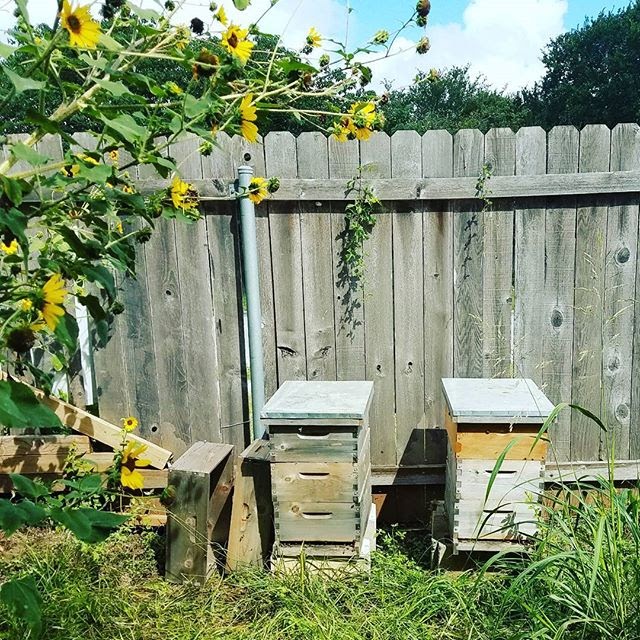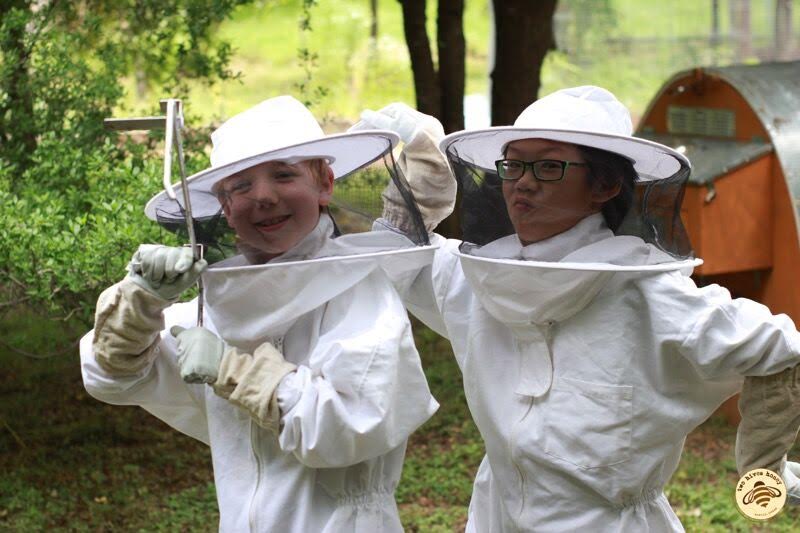Getting Started: The Townie Bees

Here at Two Hives, we specialize in helping urban beekeepers get started.
While the basics of beekeeping are the same whether you are in the city or on a 20 acre farm, urban beekeeping does have some special considerations. Over the coming months we will be writing a series of blogs geared towards brand new beekeepers!
In this, our first in the series, I am answering the most common questions I get that pertain specifically to wannabe (wannabee!?) urban beekeepers looking to place bees on rooftops and small garden plots.
Will my bees have plenty to eat?
You may be surprised to hear that my urban bees here in Austin do just as well, or even better, than my hives on more rural plots outside the city! The reason? Landscaping. (I’d also be remiss if I failed to mention that Austin is a city full of folks that value herb and vegetable gardens over “useless” manicured lawns.) Keep in mind bees will forage up to 3 miles for food (or 5, depending on who you ask). But if they don’t have to travel that far, they will be more productive and conserve more energy overall. Take a look around your neighborhood. Is yours one full of rose bushes and well tended grass, or is it more common to find gardens, vines, and native blooms? If it’s the latter, your bees may be well taken care of. I preach that your bees are ultimately YOUR responsibility to feed, and I’m not talking about sugar water. Unsure about what to plant? Check out this blog to learn a bit more about how to select bee friendly plants for your yard. I wasn’t born with a green thumb (a yellow one perhaps?) but I focus on hardy herbs such as rosemary and sage and plants that are native to my region to help ensure my success. Think of plants that bloom outside of your region’s main growing season to help extend your bees’ forage calendar. The Lady Bird Johnson Wildflower Center’s website has an extensive database of plants that are of special value to honey bees. Filter by those native to your state, plant type, bloom period, light requirement and more.
I have chickens/dogs/kids. Surely they can’t coexist harmoniously!? Let’s take these one by one.
Chickens: I have seen no reason to have concerns about chickens, and several of my hives are a mere few feet from chicken coops. Chickens have been known to eat dead bees, and if you choose to employ the practice of drone culling to control for varroa mite, chickens love to eat larvae!
Dogs: Generally speaking, dogs likely pose more of a concern to individual honey bees than the other way around. For some reason most dogs love to try to bite honey bees out of the air! Of course, if a dog chooses to stick his nose in the front of a hive, the bees will quickly educate him that he is invading their space. Most dogs are quite intelligent and will learn to not stick their nose where it doesn’t belong twice. If you are the owner of one of those precious “all brawn and no brain” animals, you may want to build a sort of barrier to keep him from sniffing around the entrance.

Kids: Tending bees is a phenomenal hands-on learning experience for kids, and I highly recommend you involve your kids in the process from the very beginning. We provide hive tours and special kids classes here in Austin, and hopefully you can find something similar in your area. Plus, few things are more adorable than a kiddo in a bee suit! I bet you all have a stove in your homes, and you assuredly have taught your kids that the stove is off-limits and not to be touched. Employ the same thought process to bee hives and teach your kids the hives are not to be disturbed without adult supervision. Generally speaking, a kid can get a few feet away from a hive with few repercussions, but ensure they know they should never stand directly in front of an entrance or open the lid.
Is my yard even appropriate for bees?
First things first—you need to learn if keeping bees in your city is legal. While urban beekeeping has become quite vogue in cities such as Brooklyn and L.A., plenty of cities still don’t allow beekeeping in the city limits. Find out the regulations in your city, and follow them to a T. Most will prescribe a certain hive density to your plot size, and may require you be a certain number of feet from your neighbor’s property line. Even if regulations are lean, I recommend you place your hives, at a minimum, fifteen feet from your neighbor’s property line. If you are any closer, consider installing a sort of barrier, such as a small fence or a line of foliage (vines, bamboo, etc.) Want to learn more about the specifics of preparing your yard for bees? This blog post will help you get your site prepped for bees. A quick note on rooftops: rooftop hives are great for so many reasons. First, we know bees prefer to be higher and away from the commotion. Second, you generally don’t have to fuss with trimming grass or ground cover, and down here in the south, that can mean no small hive beetles, which pupate in the soil. However, one word of caution: think about your roof access. Climbing a ladder isn’t too bad until you have to carry a 45 pound super of honey along for the descent! Also, if you or your close neighbors have a swimming pool, make sure you place a water source for the bees within 5-10 feet of the hive. Honey bees love swimming pools, and once they establish a preferred water source it can be almost impossible to break them of that habit. Some swear by adding a few drops of lemongrass essential oil to your water to draw the bees to that particular source. Keep in mind bees drown very easily, so stones, corks, or a type of float is important to include.
My yard is pretty small. Don’t you need a lot of land to keep bees?
There are two parts to this question. First: how much space do the actual wooden hives take up? Presuming you are doing Langstroth hives, the footprint is pretty small. The boxes are only about 14″x20″. A top bar hive takes up a bit more space and can vary from one manufacturer to another. Our top bars are about 48″x18″. Multiply those numbers times the number of hive you plan on keeping Of course, you need a few feet on at least one side of the hive to stand to work, and I prefer to have a few feet on the back side to maneuver as well. The second part to this question involves how much space do you need to allot around the hives as an ‘off-limits’ zone where you would refrain from working or playing. This is a very personal question and pertains to your comfort level. However, I feel completely comfortable letting my nieces and nephews play within about 6 feet of the hives. I would provide additional space in front of the entrance to the hive, as you never want to block the forager bees’ flight path.
But what will my neighbors say?
If you have ensured that you are within your legal rights (see previous question!) then your neighbors can complain, but probably to no avail. I get asked often if you should warn your neighbors before you start hives. No, you should not warn your neighbors. However, unless you are concerned the conversation will head south quickly, I strongly encourage you to share the wonderful news that you are embarking on such a fun adventure. If your neighbors are gardeners, they likely already know the benefit of bees, but it doesn’t hurt to remind them. (A quick anecdote: my first urban site partner saw four times the yield in his garden the first year we installed the hives.) Do your research and educate yourself, and then find ways to share the experience that will resonate with your neighbors, even if its just with a bit of honey from your first harvest. If they are particularly nervous, I’d strongly recommend you ‘mask’ the hives in some way. My experience is that the old adage is true: out of site, out of mind. Building a small trellis with some beautiful vines in between the hives and the neighbor is one idea, and clumping bamboo also provides a nice privacy screen. Of course, if a close neighbor shares that her daughter is deathly allergic to honey bee venom, I’d strongly suggest you find somewhere else in town to place your hives. While you likely can’t be liable and no one could prove it was your honey bees if she were to get popped, I doubt that guilt or hassle is one you want to be burdened with.
For more tips and tricks of the trade, I’d suggest you watch more of the videos (like the one above) which you can find on our Two Hives Youtube channel for new beekeepers!
Watch our Facebook page for the seasonal events we hold virtually & at our shop for beeks of all levels. This is also a great way to mix and mingle with local beekeepers for more advice on what has worked for them throughout their journey of keeping bees!



Hello Friends,
I saw a flyer at our feedstore in Wimberley, regarding property tax incentives. I am interested in applying for a wildlife conservation permit, and the tax deduction, and would love to add bees to my zone. I feed water and care for feral cats and other wildlife, but have always wanted to protect pollinators. I’m not interested in honey/money, just want to help the environment at this time. I so appreciate your amazing farm (we took the beekeeper workshop a long while ago). Please let me know how to start this project. Thank you!
Hi Sandra,
Thanks for reaching out! We love hearing about folks looking out for bees and other wildlife. We do have clients who have agricultural exemptions that choose to have bees to qualify for the exemption. We don’t apply for the ag exemption on behalf of the client. We leave that to them (the process and details vary from county to county) I’ll send you an email with more information.